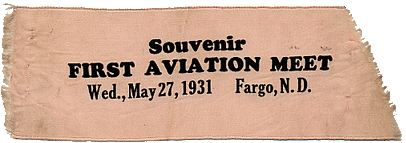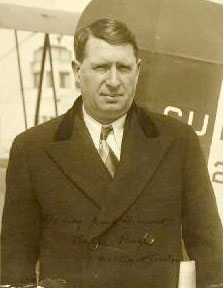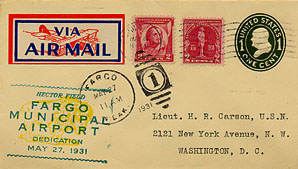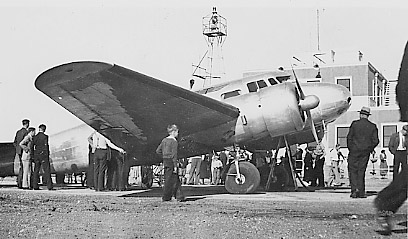Hector Field (1927-1953)
Although the first successful airplane flight in Fargo took place in 1911, the flight occurred at the old Fairgrounds. Northwest Airlines (founded at what is now the Minneapolis—St. Paul International Airport on September 1, 1926) began scheduled weekly flights into Fargo on February 1, 1928. This was a Minneapolis to Winnipeg flight with a stop in Fargo. Service was suspended after three months due to opposition from the Canadian government.
On September 9, 1927, Martin Hector leased a quarter-section of land at the northwest corner of Fargo to the city for five years at $1 per year. On April 9, 1931, Hector paved the way for Fargo's airport with his outright gift of the land. In later years Hector and his daughter-in-law, Mrs. Fred M. (Margaret) Hector, donated several additional parcels totaling nearly 50 acres that were incorporated into the present airport property, along with acreage purchased from a number of adjacent landowners.

It was February 3, 1931, when Northwest Airways began its first passenger service to Fargo. A "giant" six passenger Hamilton Metalplane settled down on the new Fargo Airport to inaugurate air service from Minneapolis to Grand Forks and then on to Winnipeg. The commemorative envelope is shown below right.

On May 27, 1931, Fargo's Municipal Airport, Hector Field, was dedicated. Brief showers failed to deter more than 5,000 Fargo residents as they came to see the dedication. The Forum reported that the roads to the airport were "choked" with cars and planes zoomed overhead.
 Walter Hinton
Walter Hinton
A.T. Lynner, President of the city commission, introduced Walter Hinton, principal speaker at the dedication. Hinton, shown right, was a Navy Lieutenant and principal pilot on the first transatlantic flight in 1919. The U.S. Navy's NC-4 Flying Boat made the first transatlantic flight from May 8-27, 1919. Lieutenant Albert C. Read accompanied Hinton on the historic flight in the two-seat airplane. The NC-4 took off from the Naval Air Station Rockaway on Long Island, New York and after a refueling stop, engine repairs and weather delays, landed in Lisbon, Portugal. Hinton was also the first person to pilot a plane from North America to South America and the first to do aerial exploration of the Amazon on a National Geographic expedition.
Hinton, on a mission to promote civil aviation for the Exchange Clubs of the U.S., spoke about the history of aviation. The speeches, starting at 10:45AM, were kept short because of the darkening skies.
Cash prizes were given to the first 20 pilots landing in Fargo between 10 and 11 AM. The first to arrive was J.M. Bacon of Grand Forks who reportedly landed by clearing a fence by only 5 feet! He entertained the crowds with stunt flying throughout the day. Other pilots similarly thrilled the crowd but three Navy fliers from Minneapolis were reported as the best fliers of the day with their precision formation flying.

Drum and bugle corps and bands from the AOUW lodge, NDAC, and high and military groups performed for the dedication and squads from the local National Guard unit marched over the field.
The dedication ended with a street dance at First Avenue between Roberts Street and Broadway.
Pictured in two postcards below is the original Hector Field Terminal. The Christmas card likely depicts the men and women who worked at the facility. Their names (clockwise from the upper right) are Lloyd Jensen, Cliff Gohdes, Ken Diehl, Celia Fattore, Bill Harrison, Bob Wall, Duane Jennings, Man Johnson, John Ewald, and Wally Kuhr. This building was replaced in 1953 with the terminal shown below. The date of construction of the original terminal is undetermined.



The photograph to the right was taken in 1938, seven years after the dedication of Hector Field. Behind the plane, one can see the original terminal building.
Early Air Tragedies
On June 24, 1937, Earl S. Rentz, pilot, and Elliott H. Netzer, passenger, died in a 15,000 foot plunge, as their plane crashed at dawn 3 miles from Moorhead. The weather observation plane had departed from Hector Airport and was the first fatal plane crash associated with the airport.
On October 30, 1941, pilot Clarence Bates was one of the few survivors in a crash that killed 14 on a Northwest flight bound to Fargo. Two Fargo residents, E.A. King and Ned Wells, were among the fatalities. Ice was believed to be the cause of the crash.
